Share this
What Sales & Marketing Teams Should be Tracking: Big Data Part 3
by Chris Peer on Mon, Apr 01, 2013 @ 01:00
In Big Data Part 1 we discussed the power of Big Data and how companies are using it to grow profitability. In Big Data Part 2 we presented the three most common misconceptions about embracing a big data strategy. In Part 3 we present what you should be tracking to improve your sales and marketing efforts.
Simple & Easy to Collect
From a sales and marketing perspective, we can now collect and process data in such a way that we can tell you exactly what your customers are thinking, what they want and what they are doing. As an example, if someone is at work and visits your website, you can attain the following data, all without the visitor willingly providing this information:
- The business the visitor to your website works for
- Where the business is located, including address, phone number, revenues, employees, etc. (See map image below)
- What the visitor typed into a search engine to find your website
- Which ad the visitor clicked on (if any)
- What website the visitor came from
- What pages the visitor visited on your website, what information they consumed and on what days
- How many times they have visited your website, by date
- How many employees from that same company visited your website, on specific dates
The screen shots below show an example from our website. On December 17, 2012 someone from the Cleveland Clinic Foundation visited our website at SyncShow.com. Our technologies tracked the following information.
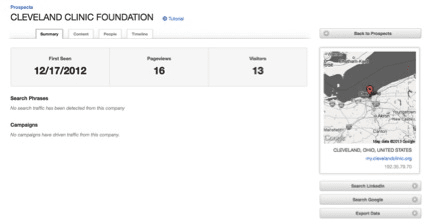
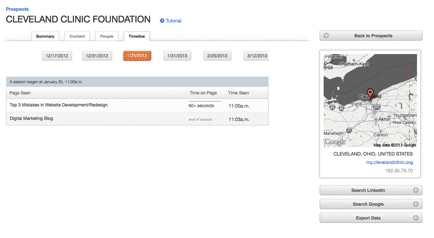
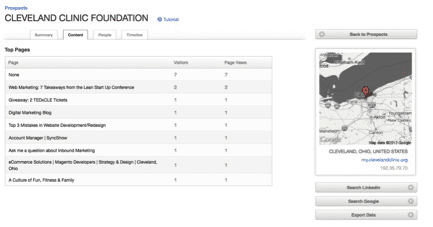
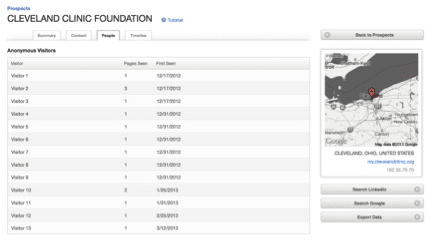
You may be saying; "That's great but I need names of prospective customers and not just companies". Well, you can often get that information too. Many other companies are already employing these tactics to run circles around their competition. You can attain information about an individual when they visit your website including:
- Person's name and email address
- Company name and phone number
- How they found your website, what search term they may have entered or ad clicked
- What pages they visited on your website, how often and on which days
- Whether they read your emails or and what website pages the visited after opening your email
- If they downloaded your awesome content, watched a video or signed up for a demo
- When they converted from a visitor to a lead
- …and more
The information in the image below has been modified to ensure no personal information has been shared.
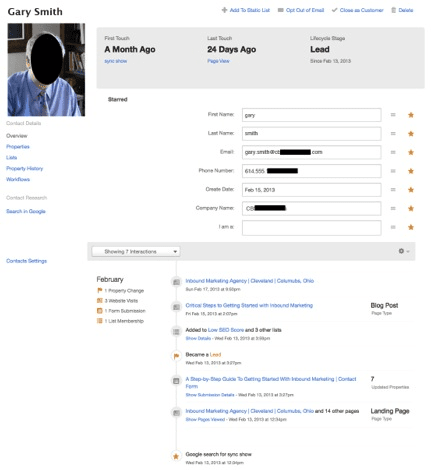
Let’s take all of this a step further. As referenced in Part 1: What if you could track a sale at your company all the way back to the initial contact that customer had on your website or corporate social media presence. What if you could track how many sales dollars you generated from your Facebook page or LinkedIn account? What if you could take all of this data, identify patterns and make informed, educated decisions about how to optimize your entire marketing and sales effort? With a little effort you can. First off you will need to implement two key integrated systems: Marketing Automation Software and CRM Software. My preferences are HubSpot or Act|On for marketing automation and SalesForce.com or Microsoft Dynamics for CRM. Second, you may want to sit down with your marketing and sales teams to discuss your strategies for lead generation and sales processes. When properly set up and integrated you can begin to harness the real power of big data. If you are not leveraging a big data approach to marketing and sales you are missing the majority of your opportunities.
Share this
- Inbound Marketing (126)
- Manufacturing (82)
- Lead Generation (70)
- Website Design & Development (58)
- Social Media (46)
- Online Brand Strategy (39)
- eCommerce (33)
- B2B Marketing (32)
- Digital Marketing (30)
- Expert Knowledge (30)
- Company Culture (22)
- Content Marketing (17)
- Customer Experience (15)
- Metrics & ROI (15)
- Search Engine Optimization (15)
- Marketing and Sales Alignment (12)
- Transportation and Logistics (11)
- Content Marketing Strategy (9)
- Email Marketing (9)
- SyncShow (9)
- Digital Content Marketing (8)
- Digital Sales (8)
- General (8)
- Lead Nurturing (8)
- Mobile (7)
- Brand Awareness (6)
- Digital Marketing Data (4)
- Transportation Insights (4)
- Video Marketing (4)
- LinkedIn (3)
- Professional Services (3)
- Account-Based Marketing (2)
- Demand Generation (2)
- High Performing Teams (2)
- Marketing Automation (2)
- News (2)
- PPC (2)
- SEO (2)
- SSI Delivers (2)
- Synchronized Inbound (2)
- Value Proposition (2)
- Facebook (1)
- HubSpot (1)
- In-House Vs. Outsourced Marketing (1)
- Instagram (1)
- KPI (1)
- Networking (1)
- Paid Media (1)
- Retargeting (1)
- StoryBrand (1)
- Storytelling (1)
- January 2025 (4)
- December 2024 (2)
- November 2024 (4)
- October 2024 (4)
- September 2024 (4)
- August 2024 (4)
- July 2024 (1)
- June 2024 (1)
- May 2024 (4)
- April 2024 (1)
- March 2024 (3)
- January 2024 (2)
- December 2023 (4)
- November 2023 (3)
- October 2023 (1)
- September 2023 (4)
- August 2023 (3)
- July 2023 (2)
- June 2023 (2)
- August 2022 (2)
- July 2022 (2)
- June 2022 (1)
- March 2022 (2)
- February 2022 (1)
- January 2022 (2)
- October 2021 (1)
- June 2021 (1)
- May 2021 (1)
- March 2021 (1)
- December 2020 (1)
- October 2020 (2)
- September 2020 (1)
- August 2020 (3)
- July 2020 (3)
- June 2020 (4)
- May 2020 (2)
- April 2020 (3)
- March 2020 (9)
- February 2020 (5)
- January 2020 (6)
- December 2019 (5)
- November 2019 (7)
- October 2019 (6)
- September 2019 (8)
- August 2019 (5)
- July 2019 (5)
- June 2019 (3)
- May 2019 (2)
- April 2019 (1)
- March 2019 (2)
- February 2019 (1)
- January 2019 (2)
- November 2018 (1)
- October 2018 (1)
- September 2018 (1)
- August 2018 (1)
- May 2018 (2)
- March 2018 (1)
- November 2017 (1)
- October 2017 (1)
- September 2017 (1)
- August 2017 (2)
- July 2017 (2)
- May 2017 (1)
- April 2017 (1)
- February 2017 (1)
- January 2017 (1)
- December 2016 (1)
- November 2016 (8)
- October 2016 (7)
- September 2016 (2)
- August 2016 (2)
- July 2016 (6)
- June 2016 (3)
- May 2016 (4)
- April 2016 (6)
- March 2016 (6)
- February 2016 (7)
- January 2016 (7)
- December 2015 (6)
- November 2015 (2)
- October 2015 (3)
- September 2015 (2)
- August 2015 (4)
- July 2015 (9)
- June 2015 (9)
- May 2015 (8)
- April 2015 (8)
- March 2015 (9)
- February 2015 (7)
- January 2015 (8)
- December 2014 (7)
- November 2014 (7)
- October 2014 (5)
- September 2014 (4)
- August 2014 (4)
- July 2014 (5)
- June 2014 (4)
- May 2014 (5)
- April 2014 (4)
- March 2014 (7)
- February 2014 (9)
- January 2014 (7)
- August 2013 (2)
- July 2013 (4)
- June 2013 (6)
- May 2013 (7)
- April 2013 (7)
- March 2013 (8)
- February 2013 (5)
- January 2013 (7)
- December 2012 (4)
- November 2012 (4)
- October 2012 (2)
- September 2012 (1)
- July 2012 (1)
- April 2012 (4)
- March 2012 (5)
- February 2012 (2)
- January 2012 (3)
- November 2011 (1)
- May 2011 (3)
- April 2011 (1)
- March 2011 (1)
- February 2011 (1)
- December 2010 (2)
- November 2010 (3)
- August 2010 (1)
- July 2010 (1)
- May 2010 (2)
- April 2010 (1)
- January 2010 (1)




